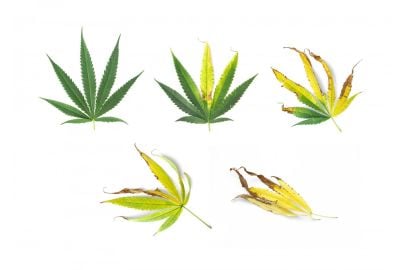Cannabis Leaf Problems: Symptoms And Solutions
Whether you're an experienced cultivator or a newbie, cannabis leaf problems come with the territory. These troubles can turn you into Sherlock Holmes as you scratch your head wondering what went wrong and how to fix it. We're here to help with that.
Keep reading to explore the four broad categories of marijuana leaf issues. We’ll investigate care-related concerns, nutrient deficiencies, parasites and pests, and weed diseases.
Find out what they are, their remedies, and how to avoid them altogether. The next time you buy weed seeds, you'll be ready for whatever nature throws your way.
Let's get started.
Marijuana leaf problems: Human errors
So, you bought pot seeds from a cannabis seed bank, but something doesn’t seem right with your crops. Some weed plant problems come from how you tend to them. Since the crops prefer balance in their environment, several issues arise when you smother them with excesses.
Similarly, you might not be providing enough of what they need. The secret to healthy marijuana is finding that sweet spot, an equilibrium for their requirements. Failure to achieve this results in cannabis leaves with issues.
Here are the common cannabis care problems:
Underwatering and overwatering
Believe it or not, many cultivators struggle with how often they should water their herbs. Too much suffocates them as the moisture damages the roots' air pockets. On the other hand, too little slows down the growth rate and reduces yields if they make it to harvest.
The marijuana leaf problems associated with overwatering or dehydration include:
- Drooping
- Curling or bending
- Discoloring from green to yellow
The foliage feels rigid or succulent when they have excess water, but they become crispy, paper-thin, and weak without enough.
To fix and avoid cannabis leaves with issues caused by overwatering:
- Stop hydrating for three days to give them time to soak up the extra moisture.
- Test the growing medium by dipping a finger in to see whether it's damp. Irrigate only when it’s not.
- Use a top-quality organic soil mix to ensure you have proper drainage.
- Add gravel or pebbles to your heavy soil to encourage efficient aeration.
To beat the dryness and treat weed leaves with problems:
- Irrigate immediately and install pumps with timers that ensure a regular schedule without your presence.
- Reduce the watering intervals or increase the amount you give.
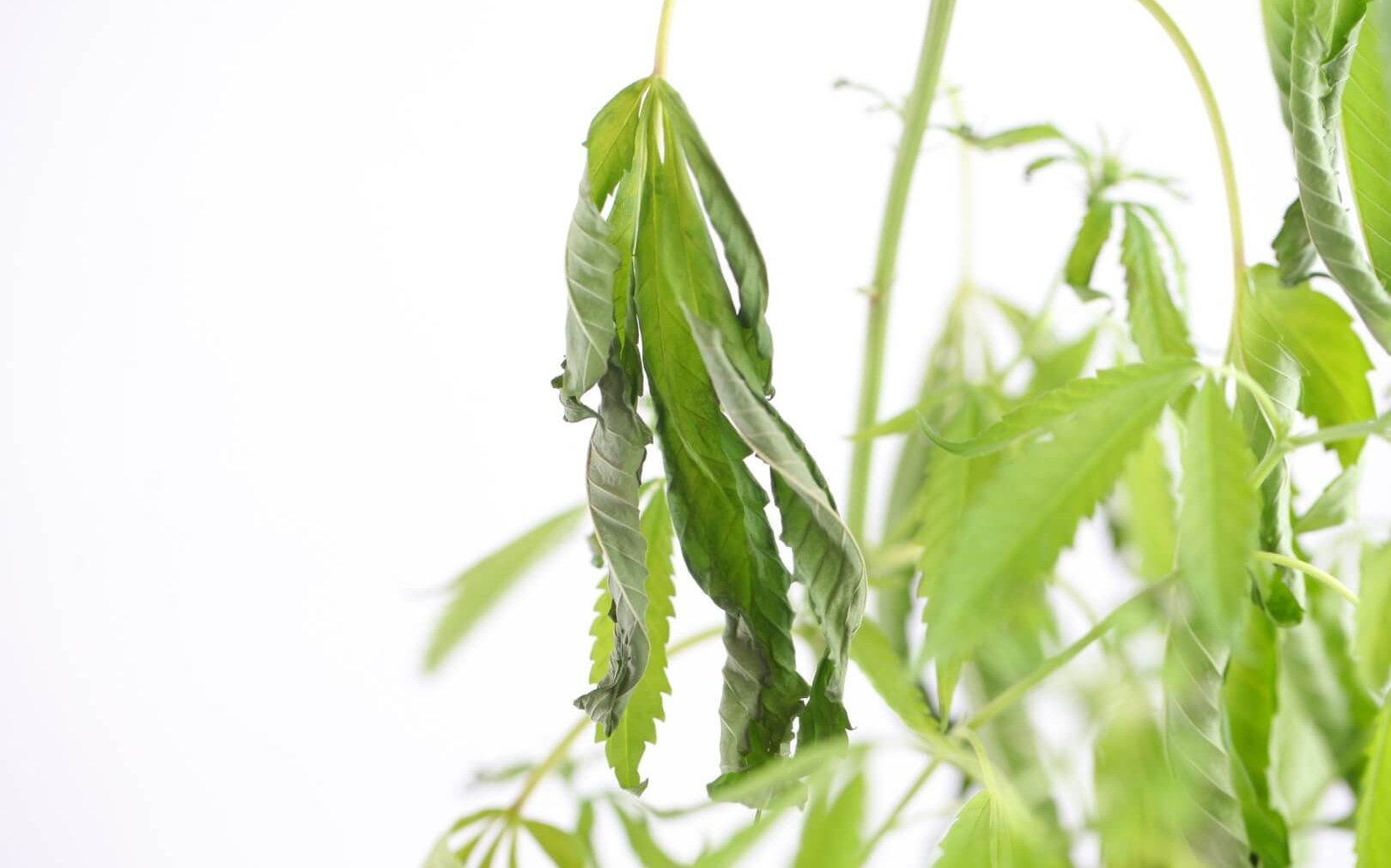
Nutrient burn
Cannabis nutrient burn is the stress your marijuana plants experience when you give them more nutrients than they require.
The early warning signs that alert growers to the weed leaf problem include:
- Leaves turn deep green
- They bend at the tips
- They start yellowing or browning
Symptoms of advanced nutrient burn include:
- The yellowing or browning moves back along the edges
- A yellowish halo separates the healthy tissue at the center of the leaf from the edges
- The curling and twisting persists
The phenomenon resembles many other cannabis problems. Confirm that you have the correct diagnosis to avoid worsening the situation.
Prune all the damaged parts, then flush your growing medium. The water should be pure and pH-balanced. For hydroponics, test the pH and adjust with fresh aqua as required.
Cannabis light burn
Cannabis light burn happens when you subject your herbs to too much light. Weed leaves with problems form on the side directly under your grow light. They:
- Turn yellow
- Fold at the edges
- Look burnt
- Feel crisp
- Are hard to break from the branch
- Retain the green color near the veins
The stress also bleaches the buds, making them lose a considerable part of their potency. Move your light source away from the crops to rid yourself of the concern.
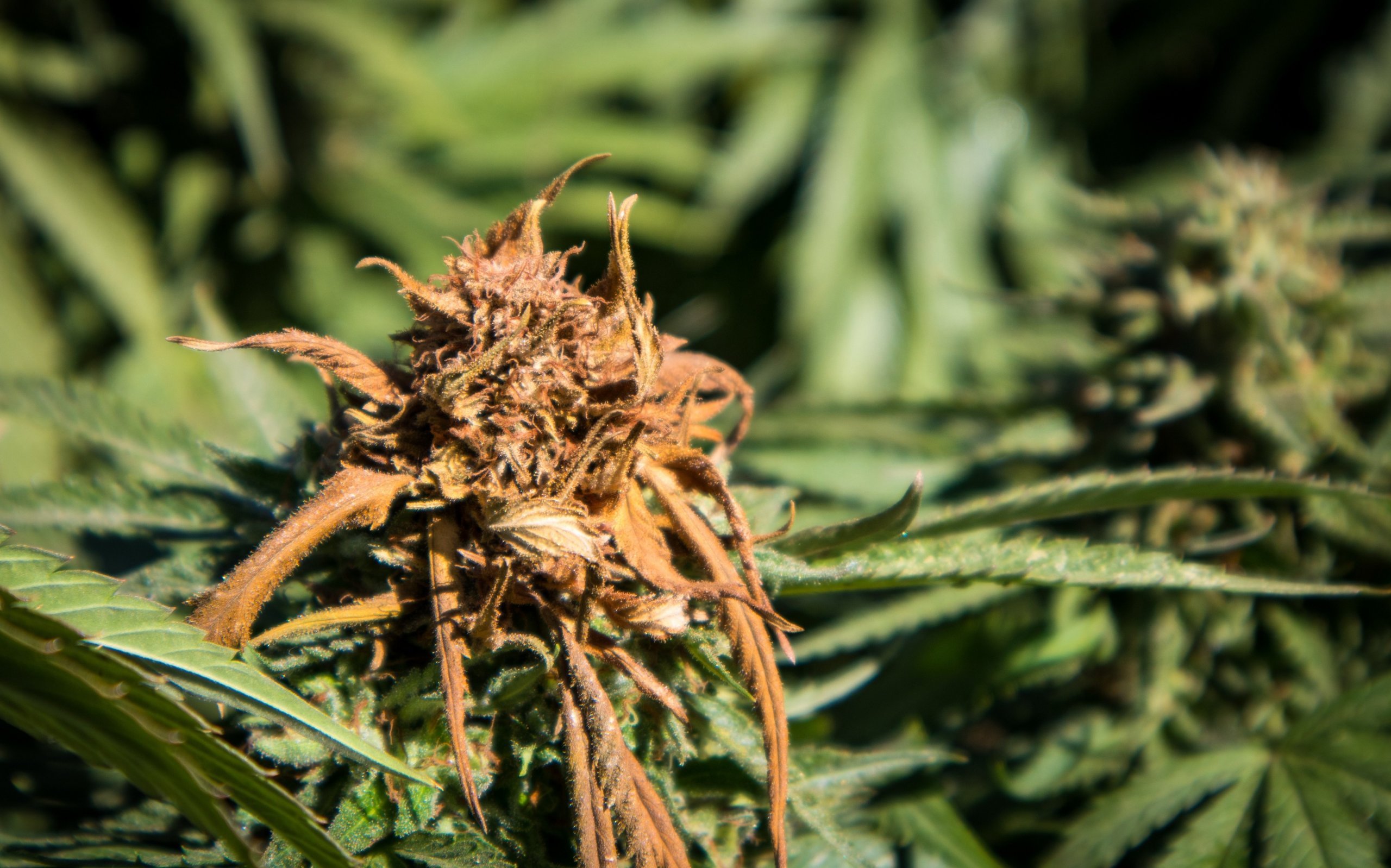
Wrong pH balance
Have you ever noticed that cultivators attribute various marijuana growing problems to the wrong soil pH for cannabis? An incorrect reading hinders several plant processes and leads to different crises.
The pH level measures of how acidic or basic your medium is. Cannabis prefers slightly acidic earth ranging from 6–6.9. In hydroponic systems, 5.5–6.5 is best.
Always keep a tester handy, and check your measurements to ensure they're within scope. It should be the first thing to confirm when you spot cannabis leaf problems.
Let it fluctuate inside the limit since marijuana takes in different nutrients at distinct points. Whenever your readings are off, correct them with pure water or use store-bought pH adjusters.
Improper humidity and temperature
Humidity and temperature for growing weed are two aspects you can never separate. Warmth leads to more transpiration which in turn raises the humidness. The increased dampness comes at the cost of several marijuana plant problems.
The perfect temp and humidity for cannabis depend on the maturity stage. Here's what the ideal environment should be:
| Stage | Temperature | Humidity |
| Seedling | 70–85°F | 75–85% |
| Early vegetative | 70–80°F | 60–80% |
| Late vegetative | 70–80°F | 45–55% |
| Early flowering | 65–80°F | 35–45% |
| Late flowering | 65–80°F | 30–35% |
Manage these factors before they cause problems with your cannabis plants. Manipulate the air circulation, spacing, watering time, and lighting to control the levels. Installing a powerful air conditioner enables you to set accurate conditions.
Marijuana plants problems: Nutrient deficiencies
All living things need nourishment for wholesome development; successful harvests come from healthy diets. Common cannabis problems occur when you provide fewer nutes than your herbs require.
You're not always to blame for the shortages, though. Other factors hinder your plants from absorbing what you give, leading to nutrient deficiencies.
Explore some nute-related issues below:
Nitrogen deficiency
Nitrogen is a critical macronutrient. It helps with chlorophyll and proteins, so photosynthesis struggles without it. Growth stunts whenever it's lacking, leading to numerous weed leaves with problems.
Nitrogen deficiency in weed exhibits the following symptoms:
- Leaves turn pale then yellow
- They curl and die, starting with those closest to the plant's base
- Other parts of the plant discolor
- Stems become purple or red
Solve the issue by confirming the pH range is optimum. Next, provide a pre-mixed nute pack or an organic supplement like urine, manure, or fish meal.
Potassium deficiency
Potassium prevents cannabis growing problems by assisting with root development, water intake, and cell division. It also aids in creating and transporting sugars and simple carbs.
Herbs that lack the nute stretch more but are weaker. The leaves curl, and the margins and tips become burnt, turning white, yellow, or brown. The veins maintain the green.
The symptoms may be confused for other marijuana leaf problems, so it's best to flush your medium before using any remedies. A foliar or nutrition feed rich in potassium, such as organic seaweed, should eliminate your troubles. Chicken manure is helpful as a top dressing.
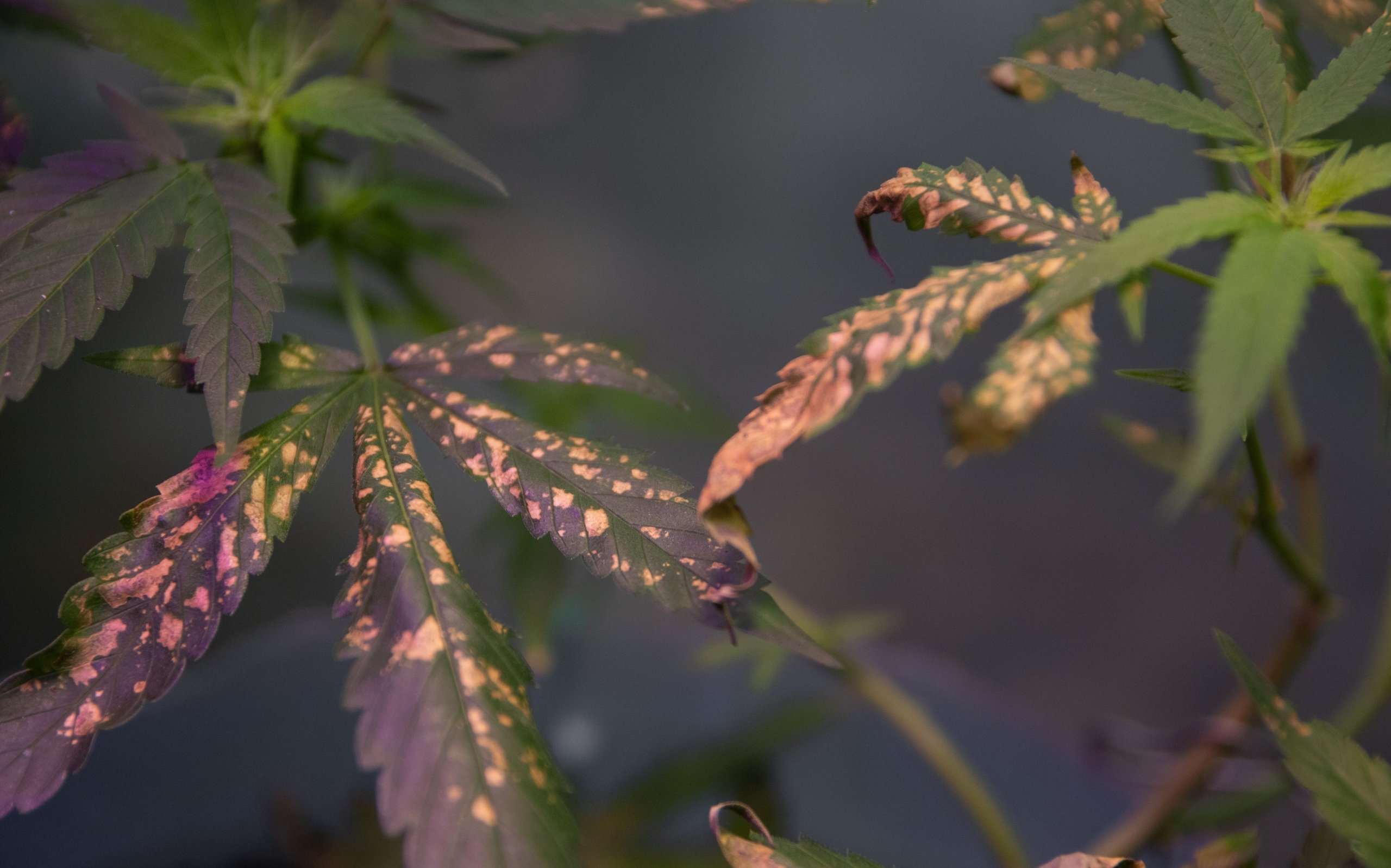
Magnesium deficiency
Like nitrogen, Mg assists in the production of chlorophyll; photosynthesis becomes a concern when it’s lacking. The weed leaf problems start with the older ones at the bottom. The herb moves the nute to the newer foliage, so they turn pale yellow or brown except for the veins.
The structure becomes abnormal with many twists, sagging, speckled patterns, and bleached nugs. Without a prompt solution, magnesium deficiency in cannabis reduces the capacity to produce any harvest. The withering persists, and death follows.
It's relatively easy to cure the cannabis plant problems listed. Confirm the pH range, then incorporate Epsom salts. Give a lower quantity and examine how your plants react.
Iron deficiency
Iron has significant roles in metabolism, chlorophyll production, respiration, and nutrient absorption.
The signs of an iron deficiency are similar to the others. The main difference is that the issues begin in the younger leaves and then progress to the rest.
As the color fades, necrotic spots come up. The good news is that the cannabis leaf problems disappear fast once you start treatment.
After flushing your weed and ensuring balance in pH, add an all-around nute pack. Foliar feeds with chelated iron fertilizers are also excellent options. Be sure to take care of your roots to prevent the matter from recurring.
Manganese deficiency
Mn promotes the formation of root cells and shields them from harmful bacteria. It also helps with photosynthesis and other crucial processes. A proper cannabis leaves diagnosis rarely points to manganese deficiency.
If it’s the culprit, it manifests from the base of new growth. Necrotic patches develop over time on old foliage, eventually affecting the tips. The edges remain green while the vein areas discolor.
Cleansing your growing medium is the best approach to rescuing your sick cannabis plant. Regulate the pH accordingly and apply it in a water-soluble form. Greensand or compost is another standard solution.
Sulfur deficiency
Sulfur assists with vegetative and root growth, proteins, and chlorophyll supply. The nute may even enhance terpenes in nugs. The loss of phosphorus (induced by a high pH level) in the root zone may result in the cannabis leaf problem.
It’s rare, but when it occurs, the symptoms match those of a nitrogen deficiency. Distinct necrosis ensues, and the issues arise in all the leaves instead of a few. They also become dry and brittle.
Continued deficit leads to diminished potency and poor yields. Use Epsom salts or potassium sulfate to replenish soil sulfur levels.

Zinc deficiency
Although Zn is only needed in small amounts, it's still noteworthy. Zinc deficiency in weed causes various marijuana plant problems as it assists in critical roles like:
- Breaking down carbohydrates
- Absorbing protein
- Developing healthy stems, stalks, and branches
- Synthesizing chlorophyll
- Making cell membranes and plant growth hormones
The shortage is especially prevalent in areas with alkaline soils and arid temperatures. Young leaf blades become wrinkly, yellow, and deformed with brown burns. Damages may become irreversible if not promptly sorted.
Zinc oxide, zinc sulfate, and chelated zinc should resolve the problems with your cannabis plants in a few days. Remember to flush your weed and maintain the ideal pH.
Phosphorus deficiency
Phosphorus is the mastermind behind DNA and RNA development for proteins and massive yields. All the other insufficiency symptoms apply here, in addition to a bluish-gray or purplish hue on the leaves. They're also stiff and dry, while the stems turn red or purple.
The phosphorus deficiency in cannabis significantly reduces both vertical and horizontal growth if left untreated. To improve absorption, fix the weed leaf problems by keeping your pH on the acidic side of the optimal range.
Provide phosphorus-rich feed or fertilizer, or even bat guano. The environment shouldn't be too cold.
Calcium deficiency
Indoor cultivators and hydroponic growers often face calcium deficiency in cannabis. It’s crucial to the structure of plants as it strengthens cell walls. A deficit might cause twists and abnormal structures in sprouting foliage.
Problems with cannabis plants come up because, without the nute, they struggle to:
- Develop healthy flowers, roots, and stomata
- Germinate
- Energize the cells
- Absorb feeds
- Resist heat
- Activate enzymes
- Facilitate the movement of carbs and nitrogen
Overcome the issues by applying lime to your substrate. You may also add Cal-Mag supplements to your nutrient-water solution.
Copper deficiency
Most growing mediums and nutrients include enough copper to meet a plant's needs, so it's not a common cannabis leaf problem. Cu supports the metabolism of carbohydrates and the use of nitrogen. It assists with flavor, color, photosynthesis, respiration, and enzyme production.
Copper deficiency in cannabis displays:
- Dark blue or purple overtones
- Yellow or white tips and margins
- Glossy leaves
- Slow-ripening buds
- Malformed structures
Rectify the condition using foliar feed containing copper sulfate, Cu sulfate, and Cu chelates. Use fungicides that incorporate it and ensure you have an ideal pH range.
Silicon deficiency
Silicon-related cannabis plant problems are few as it naturally occurs in the environment. The mineral makes cellular walls stronger, encouraging robust growth. It also slows down wilting during dry spells and fortifies herbs against pathogens and harmful substances.
Discoloration ensues, followed by drying, curling, and drooping of the foliage. The roots become underdeveloped, and the stems feeble.
Specialized liquid silicon feeds on the market help cure these cannabis growing problems. Cultivators use them to build more vigorous plants rather than to make up for a shortfall.
Boron deficiency
Cannabis boron deficiency is less frequent since it’s only needed in trace levels. The majority of high-quality soils and compost have enough of it.
Since the micronutrient stabilizes cell structures, a plant experiencing a deficit starts to wither. Expect poor vegetative development and twisted new growth. Yellowish or brownish discoloration happens on the leaves, and the roots weaken.
Tackle the weed leaf problems by cleansing your growing medium before adding more boron. Mix a teaspoon of boric acid with around a gallon of water before feeding your plant.
Molybdenum deficiency
Molybdenum is crucial in ensuring two vital enzyme systems convert nitrates into ammonium. As a result, plants can form amino acids and produce proteins.
An indicator of cannabis plant problems is when leaves' edges develop a distinctive dark orange, red, or pink hue. It gradually moves into the center, and sometimes it even shows up in the middle rather than the margins. The shape gets distorted.
Purify the medium, adjust the pH, then prepare the subsequent feed or nutrient solution. Plants only need molybdenum at minimal levels, so direct supplementation isn't necessary.
Cannabis leaf problems: Parasites and pests
When analyzing weed plant problems, the outcome often points to marijuana pests and parasites. Several little critters want a piece of your herbs and can sneak up on you before you know it.
Below are some of the most notorious ones:
Spider mites
Having spider mites on weed is one of the most dreaded experiences for growers. These tiny pests are red, orange, pale, or brown and primarily reside under leaves. They reproduce rapidly and are hard to eradicate.
They cause marijuana leaf problems such as:
- The appearance of bite marks that resemble dots.
- The formation of fine, web-like structures.
- Discoloration on the bitten areas with yellow, white, orange, or brown spots.
To save your crops:
- Separate the afflicted ones from the rest
- Snip off the infested parts
- Sprinkle natural pesticides
- Raise the moisture level as they prefer hot and dry conditions
- Add predators such as ladybugs as they can curb future attacks
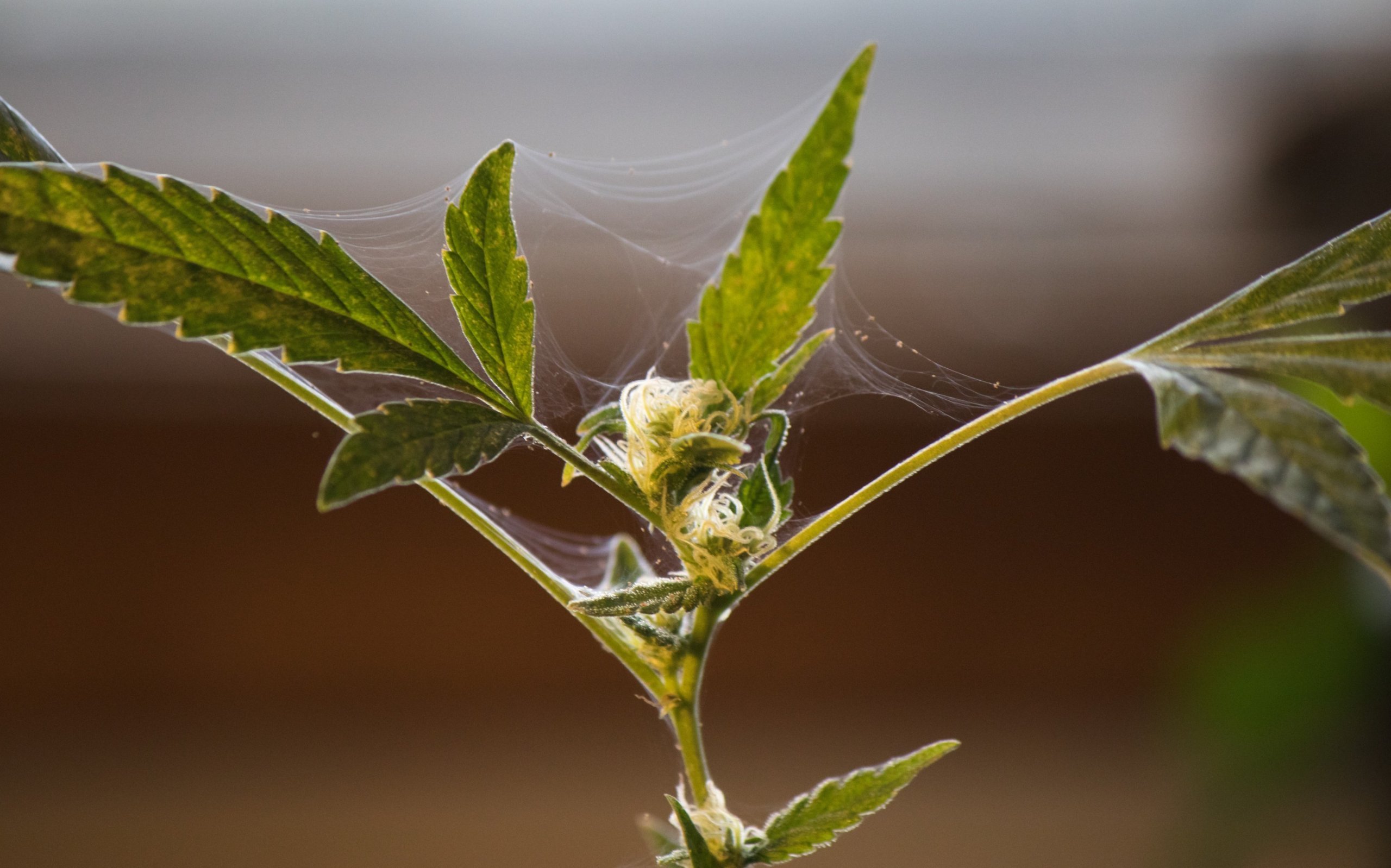
Fungus gnats
Fungus gnats are little insects with wings that throw parties in humid conditions. The larvae munch on roots and stems, inviting many other cannabis problems.
Look out for:
- Damping-off
- Paling or browning leaves
- Drooping foliage
- Diminishing growth
Place a sticky pad at the base of your shrubs and wait to get hold of numerous larvae. Afterward, blend water with peroxide and thoroughly spray on the infested areas. Repeat at least twice to be sure.

Whiteflies
You want to eliminate destructive whiteflies on cannabis as soon as you spot them. These tiny white bugs feast on your precious nugs and spread diseases, multiplying your marijuana growing problems.
They love warm environments and chilling under the weed leaves in groups. The tiny yellow bite marks are evidence of their presence, but you can confirm it by shaking your crops. A magnifying glass should help you spot the mini white eggs (usually 30–40).
Deal with these pests by applying organic home remedies like diluted garlic mixtures. Cultivate zinnias and other colorful plants to encourage whitefly predators such as hummingbirds and helpful insects.
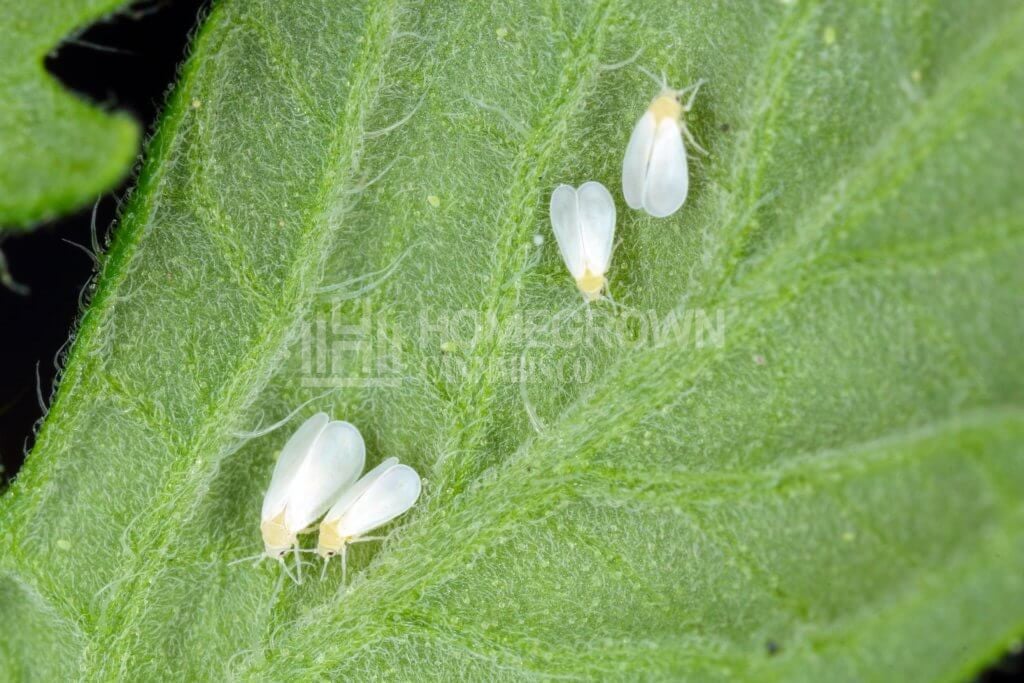
Thrips
These tiny, worm-like black pests are among the most common cannabis problems. Like whiteflies, they're quick to multiply, spread illnesses, and roam beneath the leaves.
Identifying thrips on weed is easy, although they're barely visible. They deposit black waste on the foliage and leave white marks as they suck out the sap from cells. The plants turn pale and frail while growth becomes stunted.
Use sticky traps and sprinkle garlic and neem oil mixtures to manage the marijuana plant problem. Buy some ladybugs since they feed on thrips and avoid yellow as it attracts them.
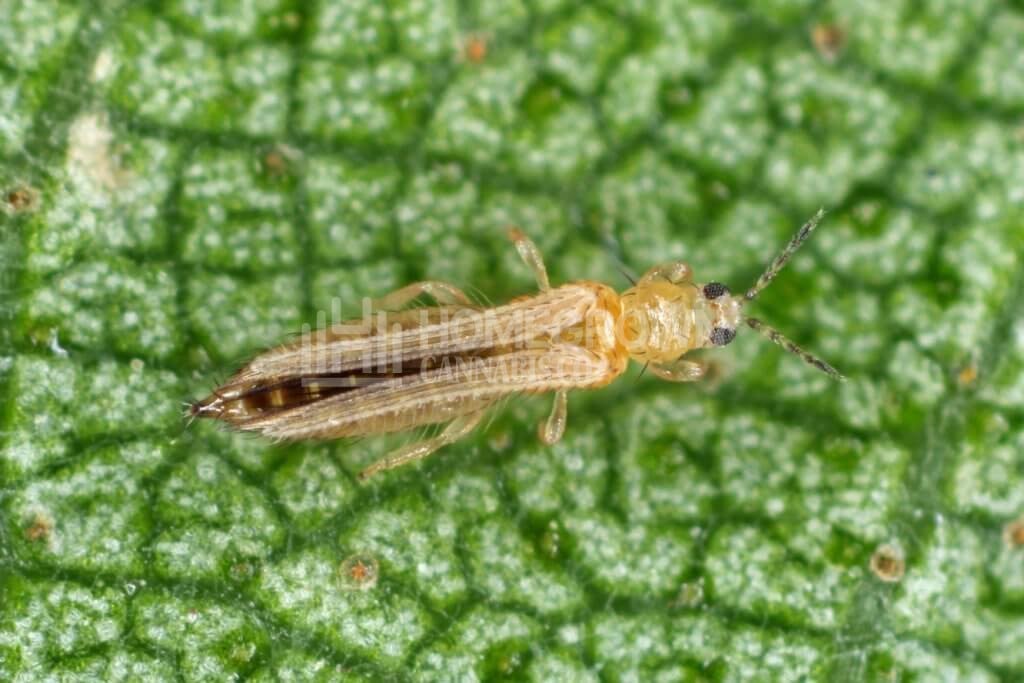
Leaf miners
You guessed it; these larvae mine leaf tissues, leaving behind a visible tunnel as they feed on juicy plant cells. These holes may be a haven for them, but they result in problems with cannabis leaves as their method is quite damaging.
Leaf miners are a combination of various insect species like moths and flies. Exterminating them is tough; use organic pesticides and neem oil to repel them.

Diseases that cause problems with cannabis plants
When identifying cannabis leaf problems remember to consider weed diseases. One of the most outstanding features of marijuana crops is resilience against brutal conditions, but resistance doesn't mean immunity.
Here's a list of some illnesses that may creep up on your plants:
Bud rot
Bud rot, also known as Botrytis cinerea, occurs due to poor humidity and ventilation management. The fungus causes marijuana plant problems such as poor water and nutrient delivery to leaves and buds. There's no need to panic since it's a common phenomenon.
It's not any less infuriating, though, so deal with it as soon as it begins to hurt your successful growing cycle. It attacks the crops through vulnerable parts like moist roots and fresh wounds or cuts.
You notice the infestation when the stems get whitish patches that later become gray and mushy. Cannabis leaf issues like yellowing and wilting start, and they may seem burnt as the situation worsens. The buds dry up, becoming gray, black, or brown.
Remove the infected bunch from the rest, then cut out the bad nugs. Thoroughly examine the other crops for any signs of rot.
Ensure ample space for your plants to lower the chances of future trouble. Keep a keen eye on humidity and air circulation.

Leaf septoria
Marijuana plants have problems from this fungal pathogen that occurs from a combination of hot and rainy weather. Nitrogen-deficient plants may also suffer from it.
Leaf septoria forms yellow and brown spots on the upper and underside of the leaves. The patches are often circular with dark brown margins and grayish centers. They begin on the lower parts of the plant and then spread upwards.
If you take too long to handle the issue, the cannabis leaf problems become more challenging. Infected ones turn yellow, then brown, and eventually wither. It also stunts growth and reduces yields.
To prevent and get rid of this condition, practice vigilance by:
- Removing affected leaves
- Pruning cluttered leaves to allow more airflow
- Quarantining affected plants until they recover
- Adding a fungicide compound to your soil mix
- Maintaining a clean growing zone and removing dead material
- Applying baking soda to subdue any further infection
Powdery mildew
White powdery mildew is one of those marijuana leaf issues that are easy to remedy. It sucks out nutrients from cells and hinders photosynthesis. If overlooked, this minor inconvenience can be catastrophic, wrecking entire harvests.
Powdery mildew on cannabis occurs in poorly aerated and highly humid environments. It manifests as white dots or dusty flour patches on your leaves.
Cover the sick marijuana plants using a polyethylene bag before removing them from the growing area. It's a safe way to ensure the airborne spores don't spread to others.
Afterward, prune the affected leaves and treat the stems with antifungal agents.
Avoid future issues by providing good airflow, proper humidity, and a clean environment. Cover your air vents with mesh, and treat new crops before bringing them into your garden.
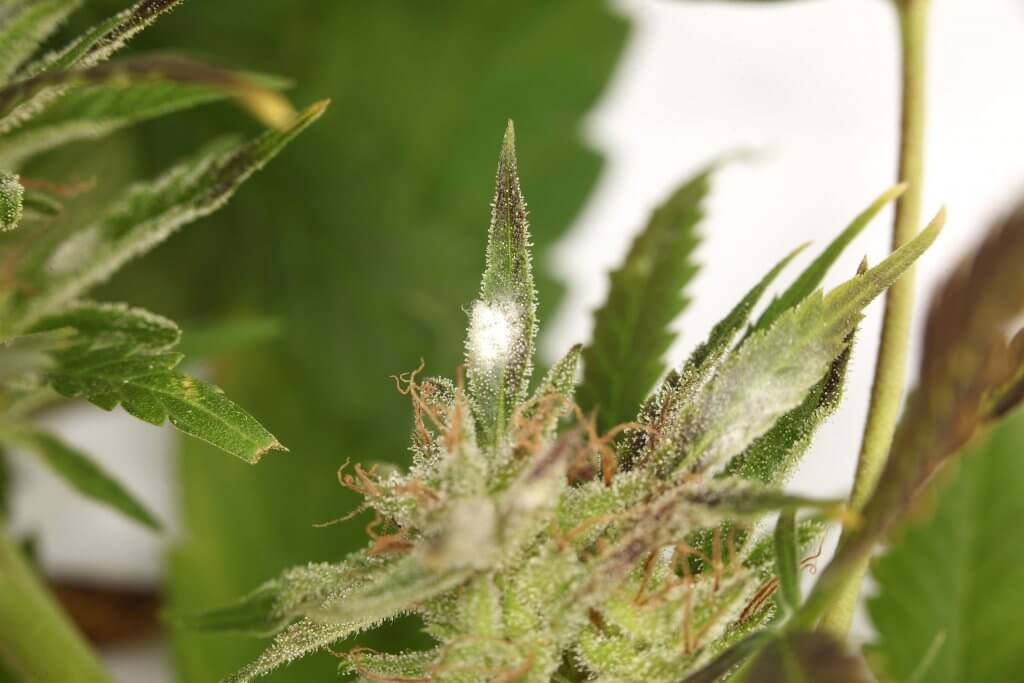
Fusarium
Fusarium is a common cannabis leaf problem that affects roots and stems. They may swell, turn red, and even decay. Depending on the severity of the issue, the herbs weaken and stop maturing. They might dry out as well, starting from the branches.
Since the parasitic fungus lasts up to 15 years in the infected ground, it's crucial to approach it cautiously. Here's what to do:
- The weed plant problem settles into a patch of ground for years, so it's best to surrender the contaminated area.
- Destroy infected crops. You're better off preventing the illness from spreading because, at the moment, it's impossible to cure your marijuana completely.
- Use a homemade fungicide. Although it doesn't treat it, the sprouts might survive. A pH level above 9.0 also helps.
- Cultivate in pots. The marijuana plant problem is more manageable when dealing with semi-isolated environments like individual containers.
- Disinfect your tools using a hydrogen peroxide solution.
- Incorporate beneficial fungi in the soil. Microbes like mycorrhizal help the shrubs absorb nutrients and possibly lower other fungal pathogens' occurrence.
Algae
Algae are one of the most important organisms on earth. They produce up to 50% of all oxygen on the planet. Despite their vital role, they can quickly become a cannabis leaf problem since algae’s ideal growing conditions are similar to marijuana.
The two end up competing for the same resources, stressing your herbs. Symptoms of an invasion include a green film on your apparatus, distorted growth, and yellowing leaves due to oxygen deprivation. There's also a moldy smell and random pH fluctuations.
It's best to prevent these cannabis leaf issues from invading your nutrient-rich and well-lit hydroponic system in the first place. Use opaque material for the tubing, buckets, and reservoirs.
If you notice an attack, clean out your equipment and add a layer of barley straw as a precaution.

Root rot
As the name implies, root rot on cannabis is a marijuana-growing problem that affects roots. It involves a collection of organisms like fungi, harmful bacteria, viruses, damping-off, and pathogens.
They hinder your crops from receiving nutrients and oxygen, leading to reduced yields. If the severe shortage persists, they die.
The infection causes drooping and curling and might be confused with severe over or underwatering. Other weed leaf problems include symptoms like:
- Burnt-looking edges
- Yellowing with brown spots
- Slowing growth
- Falling and breaking leaves
- Unpleasant odors from mushy roots
Key prevention measures consist of:
- Consistent soil drainage
- High-quality compost
- Frequent pest control measures
- Routine root controls
- Thorough equipment cleanliness
Avoid marijuana plants problems by balancing everything
There you have it, all the facts about how to diagnose cannabis plant problems. Take care of these concerns by finding a balance in the surrounding conditions. Too much or too little of anything is detrimental since it stresses your crops.
Practice the same equilibrium to avoid dealing with marijuana pests and diseases. Remember to maintain high levels of hygiene.
When it comes to nutrient deficiencies, keep two precautions in mind. First, ensure the pH is within the optimal range, and second, flush your growing medium before remedial attempts.
Now you're armed with this cannabis leaf problems guide, dealing with hiccups should be relatively straightforward. You'll be ready the next time you buy top-tier weed seeds from Homegrown Cannabis Co. Browse our site for more information about growing marijuana.
About the Author: Kyle Kushman
Kyle Kushman is a legend in the cannabis community. He is the modern-day polymath of pot: cultivator, breeder, activist, writer, and educator. After winning no less than 13 Cannabis Cups, there’s nothing this guy doesn’t know about indoor growing - he’s been there, done it, and is still doing it to this day!
